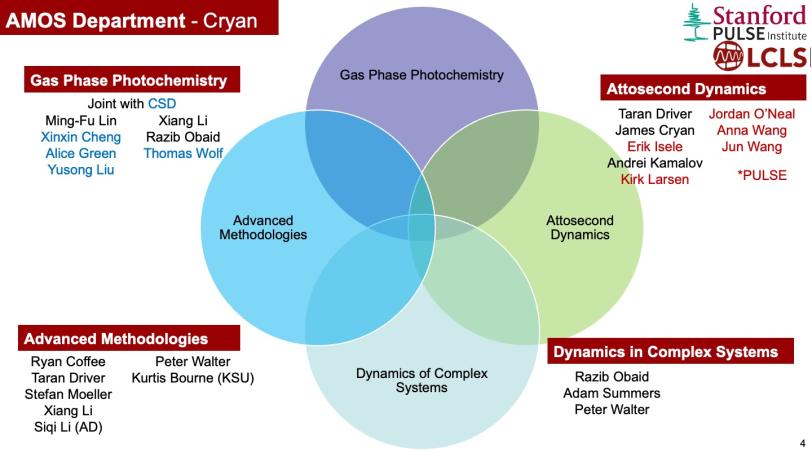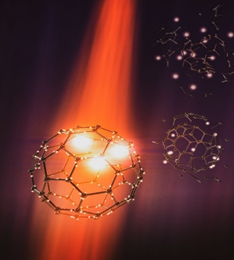AMO Research Interests

Quantum mechanics provides the foundational theory for understanding chemical reaction dynamics. Photochemical transformations provide an important intersection between the fundamental physics and chemistry of reactivity and the potential to harness light as a robust renewable source of energy. Progress towards predictive understanding of photochemical reactions requires tackling one of the great remaining challenges for electronic structure theory – the accurate and efficient treatment of electronic excited states.

High quality experimental datasets critically influence the development of new electronic structure methods for excited states. The value of vetting ab initio molecular dynamics methods with experimental observables depends critically on the information content of the ultrafast experiment. Time-resolved X-ray observables, x-ray absorption (XAS), x-ray emission (XES), resonance inelastic x-ray scattering (RIXS), and x-ray photoelectron (XPS) spectroscopies complement more traditional methods, and have the potential to provide more incisive tests of theory and simulation.
Electron motion is the means by which light energy is harnessed in photochemistry. In order to understand the earliest processes involved in chemical change, we track the evolution of electrons on their intrinsic timescales. The timescale for this motion is set by the energetic separations between electronic states, and thus evolves on the femtosecond-to-attosecond scale. This is a science frontier both for experiments and for quantum many-body theory.
Due to the atomic-site specificity offered by ultrafast X-ray pulses, electronic excitations can be precisely tracked using spectroscopic and structural (scattering) probes. The unique capabilities of LCLS-II, including tunable attosecond pulses (and pulse sequences) at high repetition rate provide a qualitative advance in our ability to track electronic motion on fundamental time and spatial scales. The high intensity offered by LCLS-II opens the door to nonlinear X-ray spectroscopies which will provide even deeper insight into the role of electronic coherence, electron-electron interactions, and electron-nuclear coupling in photo-driven chemistry.
Nanoscale physics sits at the boundary between the atomic/molecular regime and that of macroscopic, condensed matter physics - giving rise to unique behaviors and phenomena not present in any other area of physical science. As such, research into the properties of various nanoscopic systems has the potential to lead to breakthroughs in both fundamental science as well as in novel applications and technologies. On the fundamental level, research into nanoparticles, clusters, and other such complex assemblies allows for the investigation of scaling laws to understand how the physical response of a system evolves as the characteristic spatial scale changes from atomic/molecular into a macroscopic nature. On the other hand, the unique properties of nanosystems provide a number of key advantages that can be exploited to make next generation devices and technologies.

Of particular interest for advances in both fundamental and applied research is the interplay of optical fields with nanoscale systems. In plasmonic materials, the interaction of light with the nanosystem results in a collective oscillation of electrons that facilitates local, near field enhancement and nanofocusing effects. These near fields can increase the strength of the driving electric field by several orders of magnitude in intensity while additionally existing on spatial scales significantly below the diffraction limit. Driving the near-field response of nanosystems with intense, ultrafast optical pulses produces electronic dynamics at petahertz frequencies and nanoscopic spatial scales simultaneously.

The AMOS department is devoted to developing advanced methods and tools to collect and analyze data from x-ray free electron lasers. This spans a range of activities from the development of new spectroscopies and spectrometers to the development of advanced analysis techniques making use of machine learning to glean the most information from large data sets. These techniques are typically applied to one of the science areas described above, but they can (and typically are) also be exported to other science areas as well.
- "Probing Electronic Coherence between Core-Level Vacancies at Different Atomic Sites," Phys. Rev. X 15 011008 (2025)
- "`Beam à la carte`: Laser heater shaping for attosecond pulses in a multiplexed x-ray free-electron laser," Appl. Phys. Lett. 125, 191101 (2024)
- "Design and performance of a magnetic bottle electron spectrometer for high-energy photoelectron spectroscopy," Rev. Sci. Inst. 95, 125110 (2024).
- "Tracking dissociation pathways of nitrobenzene via mega-electron-volt ultrafast electron diffraction," J. Phys. B: At. Mol. Opt. Phys. 57, 195101 (2024).
- "Relativistic effects in molecular photoemission delays," Phys. Rev. A 110 L061101 (2024).
- "Attosecond delays in X-ray molecular ionization," Nature 632, 762-767 (2024).
- "Terawatt-scale attosecond X-ray pulses from a cascaded superradiant free-electron laser," Nature Photonics 18, 698-703 (2024).
- "Experimental demonstration of attosecond pump–probe spectroscopy with an X-ray free-electron laser," Nature Photonics 18, 691-697 (2024).
- “Ultrafast quantum dynamics driven by the strong space-charge field of a relativistic electron beam,” Optica 10 1-10 (2023).
- “Streaking single-electron ionization in open-shell molecules driven by x-ray pulses,” Phys. Rev. A 107, 063111 (2023).
- “Photon energy-resolved velocity map imaging from spectral domain ghost imaging,” New J. Phys 25, 033017 (2023)
- “Effect of the shot-to-shot variation on charge migration induced by sub-fs x-ray free-electron laser pulses,” Phys. Rev. Res. 5 023092 (2023)
- "Compact single-shot soft X-ray photon spectrometer for free-electron laser diagnostics," Optics Express 31, 35822-35834 (2023).
- "Applying Bayesian inference and deterministic anisotropy to retrieve the molecular structure ∣Ψ(R)∣2 distribution from gas-phase diffraction experiments," Communication Physics 6, 1-17 (2023).
- "The development of attosecond XFELs for understanding ultrafast electron motion," Advances in Atomic, Molecular, and Optical Physics 71 1-64 (2022)
- "Characterization of single-shot attosecond pulses with angular streaking photoelectron spectra," Physical Review A 105 13111 (2022)
- "Attosecond coherent electron motion in Auger-Meitner decay ," Science 375 285-290 (2022)
- "Role of nuclear-electronic coupling in attosecond photoionization of H2," Physical Review A 104 63119 (2022)
- "Correlation-Driven Transient Hole Dynamics Resolved in Space and Time in the Isopropanol Molecule," Physical Review X 11 31048 (2021)
- "Controllable X-Ray Pulse Trains from Enhanced Self-Amplified Spontaneous Emission," Physical Review Letters 106 104802 (2021)
